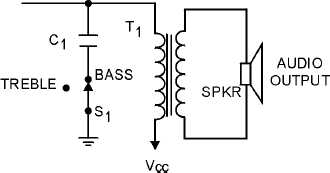2-25
Audio Tone
The tone of the sound reproduced in the audio section of a receiver depends on several factors. The
frequency response of the audio amplifiers determines the degree of amplification provided to different
frequencies in the sound spectrum. The size and quality of any loudspeaker used will determine its
response to various frequencies. Response of the human ear is the final judge of tonal quality, and that
varies with the individual.
Because of these variables, some form of tone control is sometimes used in Navy receivers. Treble
tones are defined as the audio frequencies above approximately 3,000 hertz and bass tones are those
below approximately 300 hertz. Although several methods of tone control can be used, we are only going
to mention the attenuation method. With this method, a decrease in the intensity of one tone can produce
an apparent increase in the intensity of another tone. As an example, let’s look at tones of 400 and 4,000
hertz produced by a speaker with the same intensity. If we reduce the intensity of the 4,000-hertz tone, the
400-hertz tone will appear to be louder, even though its intensity has not actually changed. You should
see from this example that bass emphasis can be accomplished by attenuating treble tones.
The simplest type of tone control is illustrated in figure 2-22. Fixed capacitor C1 parallels the
primary winding of the output transformer, effectively shunting the higher frequencies to ground. The size
of C1 determines the lowest frequency to be affected. When you select the BASS position of the tone
control, C1 is connected and improves bass response by de-emphasizing the treble tones. You can often
use this circuit to improve the output of a small speaker with poor treble response.
Figure 2-22.—Fixed capacitor tone control.
A continuously variable tone control is illustrated in figure 2-23. Tone control R1 and bypass
capacitor C1 act as a variable RC filter. With the wiper arm of R1 in the upper (BASS) position, C1
bypasses the higher frequencies to ground and provides better bass response. When the wiper arm of R1 is
in the lower (TREBLE) position, the resistance of R1 is placed in series with C1, which reduces the
shunting effect of C1 to high frequencies and improves the treble response. This method gives you the
advantage of smooth, continuous tone control at all points between maximum bass and maximum treble
response.

